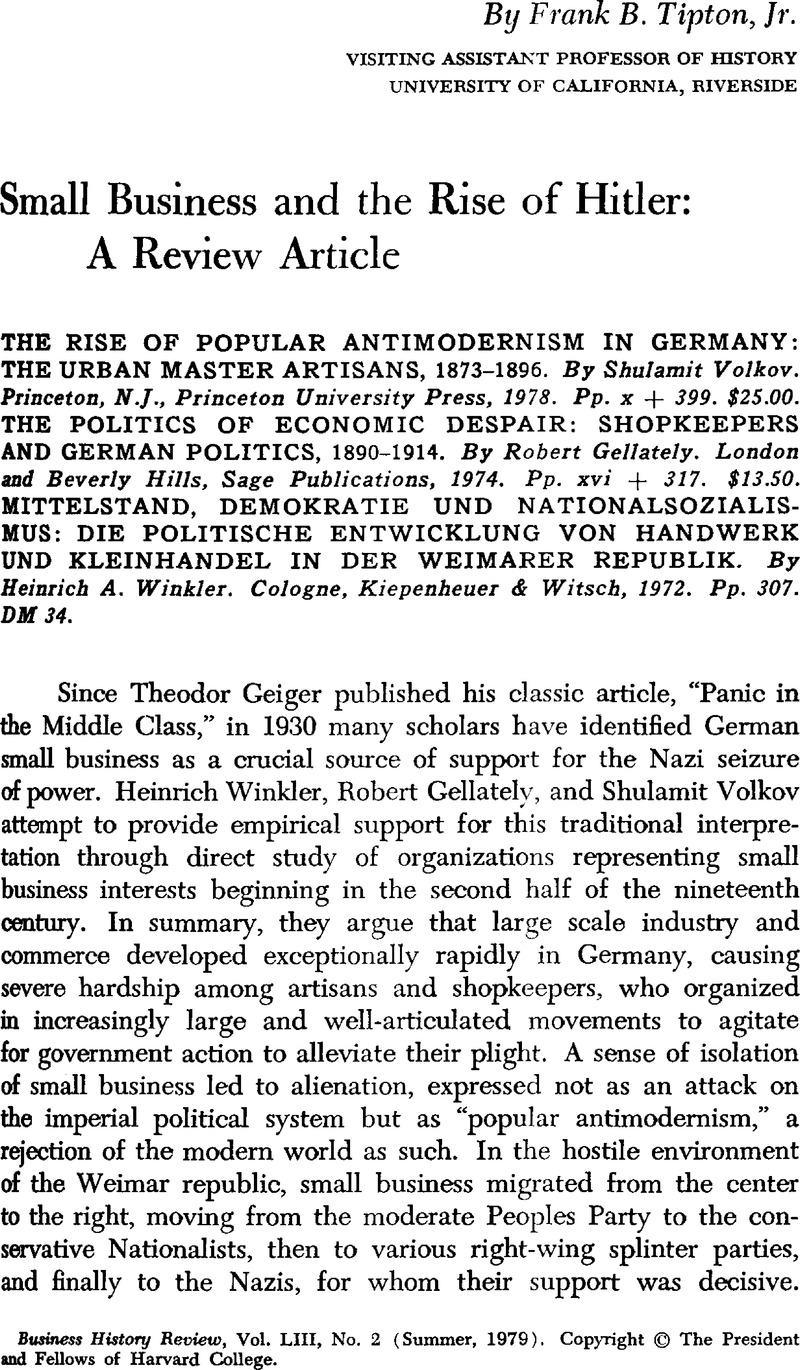Published online by Cambridge University Press: 11 June 2012

1 Winkler has summarized his views in English in “From Social Protectionism to National Socialism: The German Small-Business Movement in Comparative Perspective,” Journal of Modern History, 48 (1976), 1–18. See also Lebovics, Herman, Social Conservatism and the Middle Classes in Germany, 1914–1933 (Princeton, N.J., 1969).CrossRefGoogle Scholar
2 Volkov, 215–236. See also Pulzer, Peter G. J., The Rise of Political Anti-Semitism in Germany and Austria (New York, 1964).Google Scholar
3 Reich, Wilhelm, The Mass Psychology of Fascism (1942; New York, 1970), 48–62.Google Scholar
4 Schumacher, Martin, “Hausbesitz, Mittelstand und Wirtschafts partei in der Weimarer Republik,” in Mommsen, Hans, ed., Industrielles System und politische Entwicklung in der Weimarer Republik (Düsseldorf, 1974), 823–835.Google Scholar
5 In an article neglected by historians, Grumm, John G., “Theories of Electoral Systems,” Midwest Journal of Political Science, 2 (1954), 357–376CrossRefGoogle Scholar argues that the multiplication of parties had begun before 1914 and therefore was not the result of the Weimar system of proportional representation as many have assumed. See also Conze, Werner, “Die Krise des Parteienstaates in Deutschland, 1929–1930,” Historische Zeitschrift, 178 (1954), 47–83Google Scholar; Jones, Larry E., “The Dying Middle: Weimar Germany and the Fragmentation of Bourgeois Politics,” Central European History, 5 (1972), 23–54.CrossRefGoogle Scholar
6 Hallgarten, George W. F. and Radkau, Joachim, Deutsche Industrie und Politik von Bismarck bis heute (Frankfurt a.M., 1974), 199–202.Google Scholar
7 Turner's attempt to exonerate big business as a class from responsibility for Hitler's rise to power must now be considered a failure, though his work has eliminated several overly-simple Marxist formulations and thereby contributed to a clarification of the sociological issues involved. The debate continues, however. See Turner, Henry A. Jr., “Big Business and the Rise of Hitler,” American Historical Review, 75 (1969), 56–70CrossRefGoogle Scholar, reprinted in Turner, Henry A. Jr., ed., Nazism and the Third Reich (New York, 1972), 89–108Google Scholar; Turner, “Das Verhältnis des Grossuntemehmens zur NSDAP,” in Mommsen, Industrielles System, 919–931; Stegmann, Dirk, “Zum Verhältnis von Grossindustrie und Nationalsozialismus, 1930–1933,” Archiv für Sozialgeschichte, 13 (1973), 399–482Google Scholar; Turner, , “Grossunternehmertum und Nationalsozialismus, 1930–1933: Kritisches und Ergänzendes zu zwei neuen Forschungsbeiträgen,” Historische Zeitschrift, 221 (1975), 18–68CrossRefGoogle Scholar; Stegmann, , “Antiquirte Personalisierung oder sozialökonomische Faschismus-Analyse? Eine Antwort auf Henry A. Turners Kritik …,” Archiv für Sozialgcschichte, 17 (1977), 275–296.Google Scholar See also the review of Hallgarten and Radkau by Cecil, Lamar in Business History Review, XLIX (1975), 409–411.Google Scholar
8 Data from Kater, Michael H., “Quantifizierung und NS-Geschichte,” Geschichte und Gesellschaft, 3 (1977), 453–484Google Scholar; Douglas, Donald M., “The Parent Cell: Some Computer Notes on the Composition of the first Nazi Party Group in Munich, 1919–21,” Central European History, 10 (1977), 55–72.CrossRefGoogle ScholarKele, Max H., Nazis and Workers: National Socialist Appeals to German Labor, 1919–1933 (Chapel Hill, N.C., 1972)Google Scholar errs in the other direction, combining white collar employees with skilled and unskilled laborers, and thereby overstating the appeal of Nazism to “workers.”
9 Kaltefleiter, Werner, Wirtschaft und Politik in Deutschland: Konjunktur als Bestimmungsfaktor des Parteiensystems (Cologne, 1966).CrossRefGoogle Scholar In English see the classic study of Heberle, Rudolf, From Democracy to Nazism (1945; New York, 1970)Google Scholar emphasizing the peasantry; O'Lessker, Karl, “Who Voted for Hitler: A New Look at the Class Basis of Nazism,” American Journal of Sociology, 74 (1968–1969), 63–69CrossRefGoogle Scholar and the comment by Allan Schnaiberg, ibid. 732–735 emphasizing the shift of Conservative voters; McKibbin, R. I., “The Myth of the Unemployed: Who did Vote for the Nazis?” Australian Journal of Politics and History, 15 (1969), 25–40CrossRefGoogle Scholar, emphasizing the rural vote.
10 Levy, Richard S., The Downfall of the Anti-Semitic Political Parties in Imperial Germany (New Haven, Conn., 1975)Google Scholar; Noakes, Jeremy, The Nazi Party in Lower Saxony, 1921–1933 (New York, 1971), 222–232.Google Scholar
11 See Timothy W. Mason, “The Primacy of Politics — Politics and Economics in National Socialist Germany,” in Turner, Nazism, 175–200; Schoenbaum, David, Hitler's Social Revolution: Class and Status in Nazi Germany 1933–1939 (New York, 1966).Google Scholar
12 For the United States, see Bunzel, John H., The American Small Businessman (New York, 1962)Google Scholar; for France, see Hoffmann, Stanley, Le Mouvement Poujade (Paris, 1956)Google Scholar; for England, see Raynor, John M., The Middle Class (New York, 1969)Google Scholar; for Japan, see Shinohara, Miyohei, “A Survey of the Japanese Literature on Small Industry,” in Hoselitz, Bert F., ed., The Role of Small Industry in the Process of Economic Growth (Paris, 1968)Google Scholar and the chapter on the producers' cooperative movement in Downard, J. Douglas, “Tokyo: The Depression Years, 1927–1933” (Doctoral Thesis, Indiana University, 1976).Google Scholar
13 See, for instance, Weber, Eugen J., Action Française (Stanford, 1962), 259–275, 410–431.Google Scholar
14 Kocka, Jürgen, Angestellte zwischen Faschisumus und Demokratie: Zur Sozial-geschichte der Angestellten, USA 1890–1940 im internationalen Vergleich (Göttingen, 1977)CrossRefGoogle Scholar, provides an interesting comparison of white collar movements in Germany and the United States touching on the same themes as Winkler's work on small businessmen. An English translation is forthcoming.